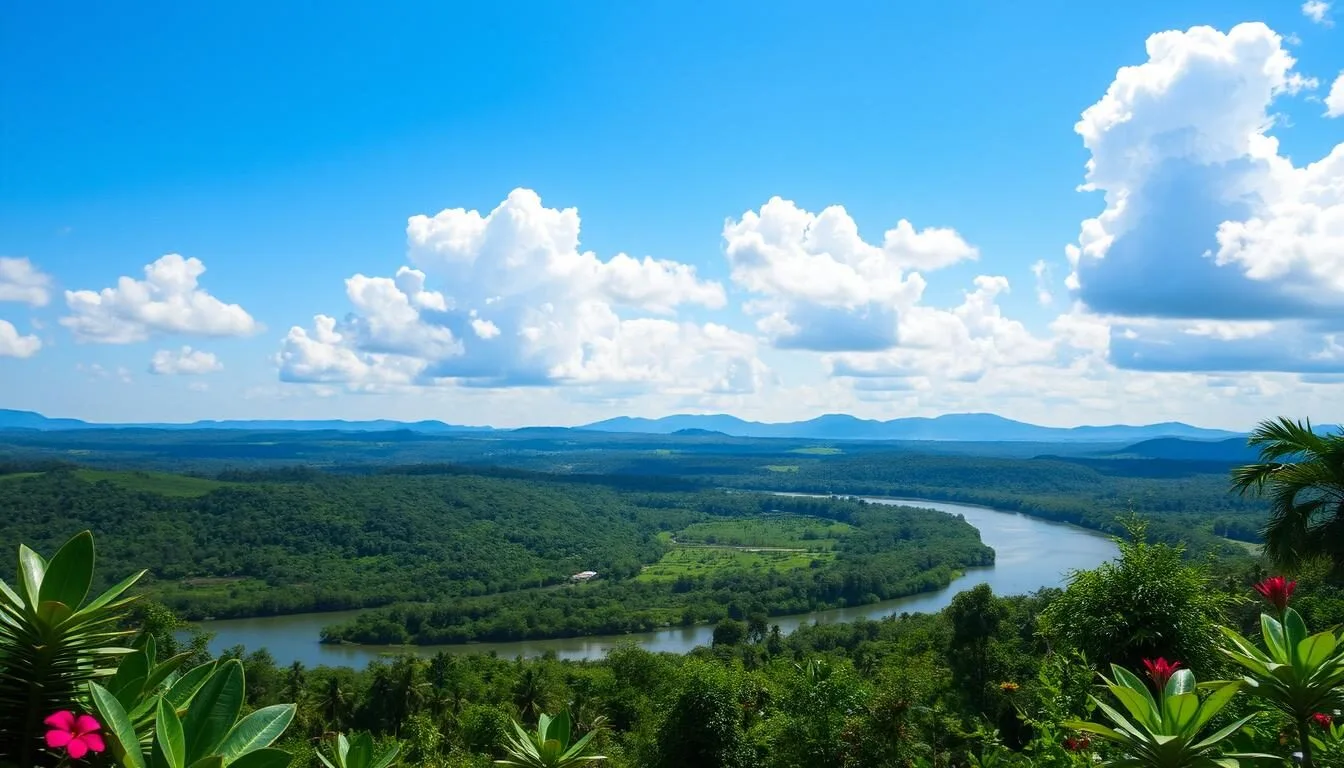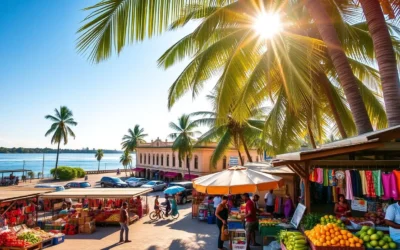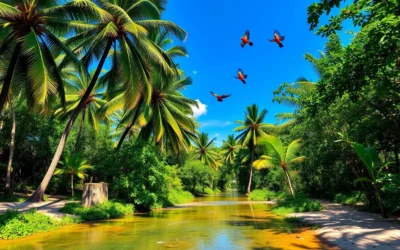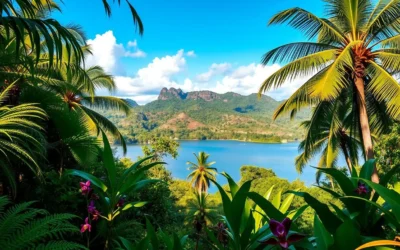✓ Accommodations✓ Flights✓ Rental Cars✓ Tours & Activities
Are you planning a trip to this South American gem and wondering when to go? Suriname’s climate is hot and humid, with temperatures between 75°F and 91°F throughout the year.
Understanding the local weather patterns is key to a great vacation. The country’s tropical climate means significant seasonal variations in rainfall, affecting everything from beach activities to wildlife viewing.
The ideal time to visit depends on your tolerance for rain and humidity. The best time for hot-weather activities is from early July to early November and from late December to early April.
This guide will help you identify the best months for your adventure, highlighting the top things to do during each season and helping you avoid the heaviest rainfall periods.
Understanding Suriname’s Tropical Climate
Suriname has a tropical climate with significant regional variations. The country’s position just north of the equator creates a tropical climate that varies significantly throughout different parts of the country.
The climate is characterized by two distinct seasons: a dry season and a wet season. The Atlantic Ocean plays a crucial role in moderating temperatures along the coastal regions, while inland areas experience more extreme weather patterns.
Geographic Influences on Weather Patterns
Some key factors influencing Suriname’s climate include its tropical location near the equator, the moderating effect of the Atlantic Ocean on coastal temperatures, and more extreme weather patterns in inland areas.
- Its tropical location near the equator
- The moderating effect of the Atlantic Ocean on coastal temperatures
- More extreme weather patterns in inland areas
- The presence of two main seasons: wet and dry
- Relatively stable annual temperatures, ranging from 75°F to 91°F
The country’s rainforest coverage also influences local humidity and rain patterns, creating microclimates that can surprise unprepared travelers.
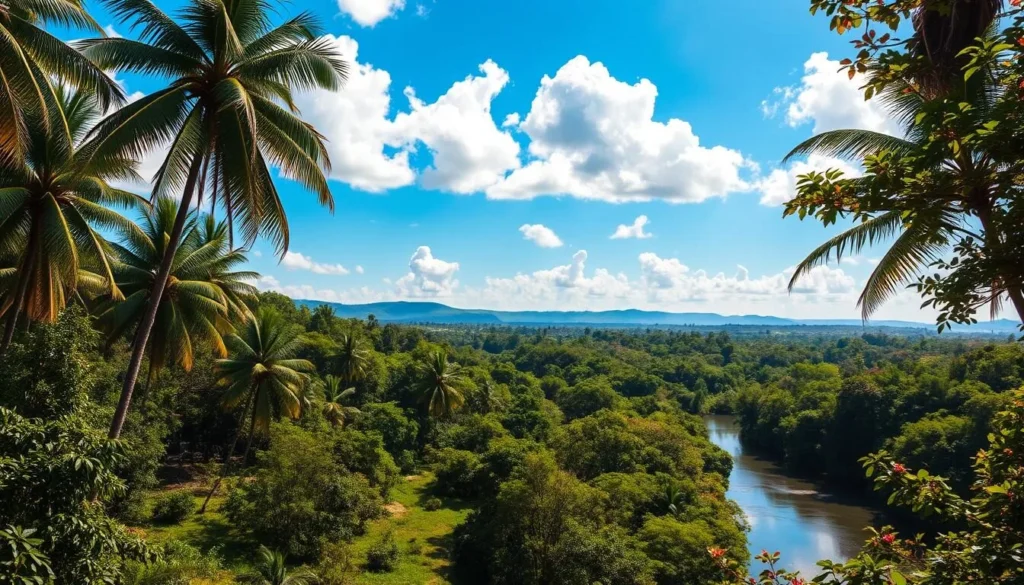
Suriname’s Dry Season: The Prime Time to Visit
The dry season in Suriname, which spans from August to November, offers ideal weather conditions for travelers. This period is characterized by clear skies, lower humidity, and warm temperatures ranging from 80°F to 90°F.
Weather Characteristics from August to November
During these months, Suriname experiences its peak dry season, making it the best time to visit for those seeking minimal rainfall and optimal weather conditions. The dry season creates ideal conditions for exploring Suriname’s interior rainforests and nature reserves.
- Clear skies and lower humidity make outdoor activities more enjoyable.
- Temperatures remain warm but comfortable, typically between 80°F and 90°F.
- October is the driest month, with an average rainfall of just 1.4 inches, making it perfect for outdoor explorations.

| Month | Average Rainfall (inches) | Average Temperature (°F) |
|---|---|---|
| August | 2.2 | 85 |
| September | 1.8 | 86 |
| October | 1.4 | 87 |
| November | 2.0 | 86 |
This period is considered prime time for visiting Suriname’s beaches along the Atlantic coast, as the reduced rainfall means more sunny days for swimming and sunbathing.
Navigating the Wet Season in Suriname
Understanding Suriname’s wet season is essential for travelers and locals alike, as it impacts various aspects of life. The wet season, which lasts for approximately 7.8 months, from December 10 to August 4, brings significant rainfall to the region.
The wet season reaches its peak intensity during May, June, and July. During this critical part of the year, the weather conditions are characterized by heavy rainfall, with May receiving the highest average rainfall of approximately 9.8 inches.
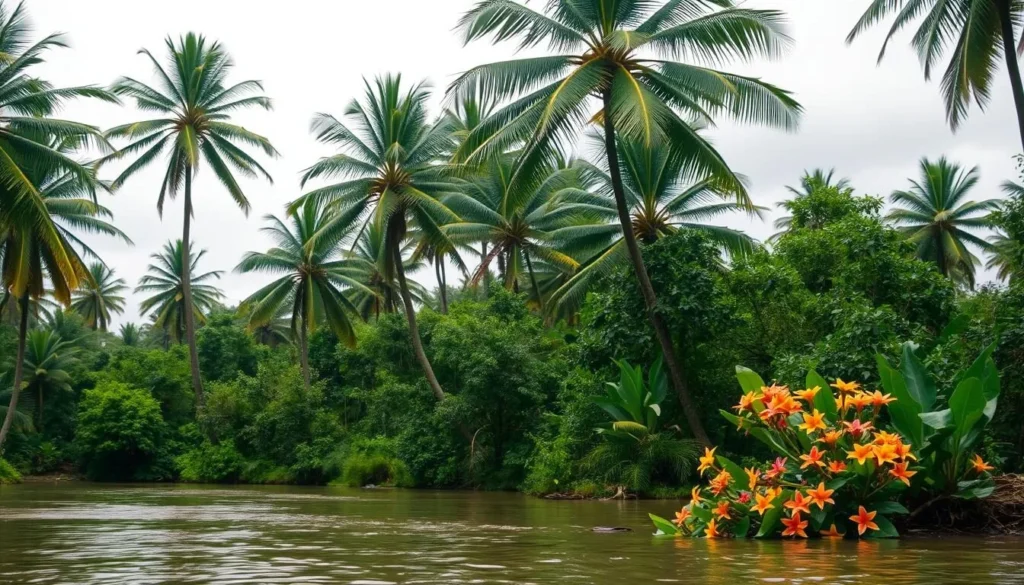
May to July: Early Rainy Season
During May to July, the early rainy season in Suriname is at its peak. June presents the greatest challenge for travelers, with an average of 25.5 wet days, making outdoor activities difficult to plan. However, this period also offers unique advantages for wildlife enthusiasts, as the abundant water creates ideal conditions for spotting certain species.
- The wet season brings heavy rainfall, transforming parts of Suriname into lush landscapes.
- Morning explorations are recommended, as afternoon showers follow a predictable pattern.
Temperature Patterns Throughout the Year
Understanding Suriname’s temperature patterns is crucial for planning a comfortable and enjoyable trip. The temperature in Suriname remains relatively consistent throughout the year, with average highs ranging from 85°F to 90°F and lows rarely dropping below 75°F.

Average Monthly Temperatures
Over the course of the year, the temperature typically varies from 75°F to 91°F and is rarely below 73°F or above 94°F. The hottest time of year typically occurs from August through October, coinciding with the latter part of the dry season when heat can build up without the cooling effect of regular rainfall.
- Coastal areas benefit from Atlantic Ocean breezes that moderate temperatures, while inland regions can experience more intense heat, especially during midday hours.
- The perceived temperature in Suriname is significantly affected by humidity levels, which remain high throughout the year but peak during the rainy season.
By understanding these temperature patterns, you can plan your daily activities, with early mornings and evenings offering the most comfortable conditions for exploration regardless of the weather or season.
Best Months for Beach Activities in Suriname
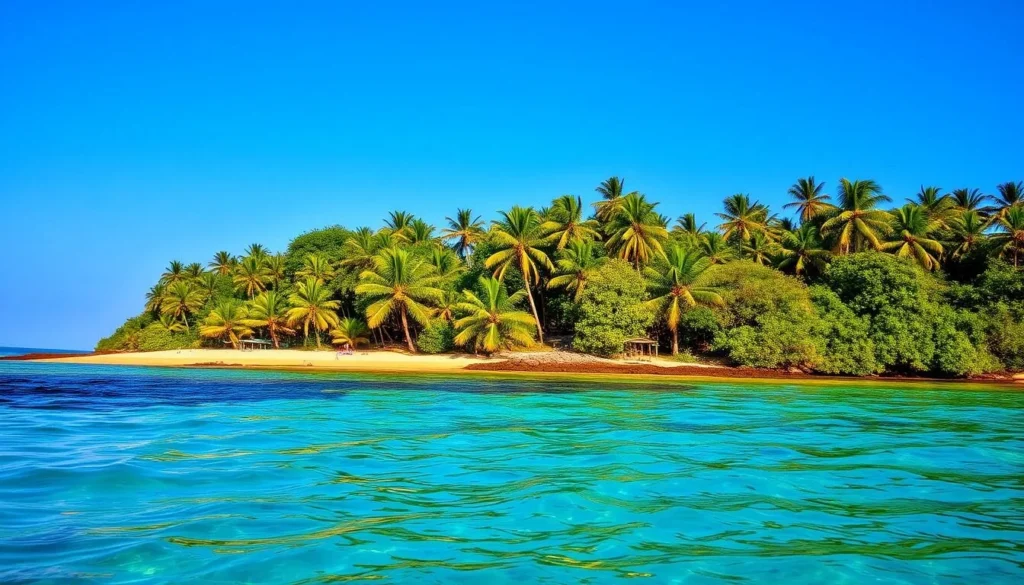
Suriname’s Atlantic coastline offers a unique beach experience, with the best time to visit being during the dry season. You can enjoy the beautiful beaches without the interruption of rain, making it ideal for various beach activities.
Coastal Weather Conditions
The coastal weather conditions in Suriname are generally more favorable than inland areas year-round. Sea breezes provide relief from the tropical heat, making the coastal regions a comfortable destination for beachgoers. The water temperatures along Suriname’s coast remain invitingly warm throughout the year, typically ranging from 79°F to 83°F.
The best time to visit Suriname’s beaches is from early July to early November and again from late December to early April. August and September offer optimal beach conditions with clear skies, minimal rainfall, and perfect temperatures for swimming and sunbathing. Popular destinations like Matapica and White Beach are best enjoyed during the dry season when visibility for swimming is at its best.
Optimal Times for Wildlife and Nature Exploration

When planning a trip to Suriname for wildlife exploration, understanding the optimal times is crucial. The country’s diverse wildlife and ecosystems offer a unique experience for nature enthusiasts.
Wildlife viewing in Suriname varies dramatically throughout the year. The best time to visit for nature exploration depends on which species you hope to encounter. The transition periods between wet and dry seasons (November and April) often provide the best conditions for wildlife spotting.
Rainforest Conditions Throughout the Year
The rainforest conditions in Suriname change significantly throughout the year. During the wetter season, the landscape transforms dramatically, with the countryside bursting into lush greenery. Brownsberg Nature Park and the Central Suriname Nature Reserve offer some of the best things to see year-round.
Bird watching reaches its peak during the early months of the year when many species are breeding. Beach-nesting sea turtles can be observed along Suriname’s coastline from February to August, with peak nesting activity occurring in May and June.
Regional Weather Variations in Suriname
Suriname’s climate is diverse, with significant regional variations. The country’s geography plays a crucial role in shaping its weather patterns, resulting in distinct microclimates across different regions.
The coastal regions of Suriname benefit from the moderating effects of the Atlantic Ocean, leading to more stable temperatures and predictable weather conditions throughout the year. In contrast, the interior regions, particularly around the central highlands, experience higher levels of rain even during the dry season.
Coastal vs. Interior Climate Differences
The climate in Suriname varies significantly between the coastal areas and the interior rainforest regions. While the coastal strip enjoys relatively stable temperatures, the interior regions can have more extreme variations, especially during the dry season. Understanding these differences is key to planning your trip according to the optimal weather conditions in different parts of the country.
By considering these regional weather variations, you can make the most of your time in Suriname and enjoy the country’s diverse landscapes and activities under favorable weather conditions.
Suriname: Best Months for a Weather-Savvy Trip
When planning a trip to Suriname, timing is everything. The country’s diverse attractions are best experienced during the right time of year.
August to October: Ideal Weather Window
The period from August to October represents the absolute sweet spot for visiting Suriname, offering the most pleasant weather combination of minimal rainfall, lower humidity, and comfortable temperatures. This ideal weather window coincides with peak visibility for both coastal and rainforest activities.
September stands out as particularly exceptional, with clear skies on more than half of all days and rainfall at its annual minimum. Tourist facilities operate at full capacity during these months without the overcrowding experienced in more popular Caribbean destinations.
| Month | Weather Conditions | Ideal Activities |
|---|---|---|
| August | Minimal rainfall, lower humidity | Beach activities, coastal tours |
| September | Clear skies, annual minimum rainfall | Photography, outdoor exploration |
| October | Comfortable temperatures, pleasant weather | Rainforest activities, wildlife exploration |
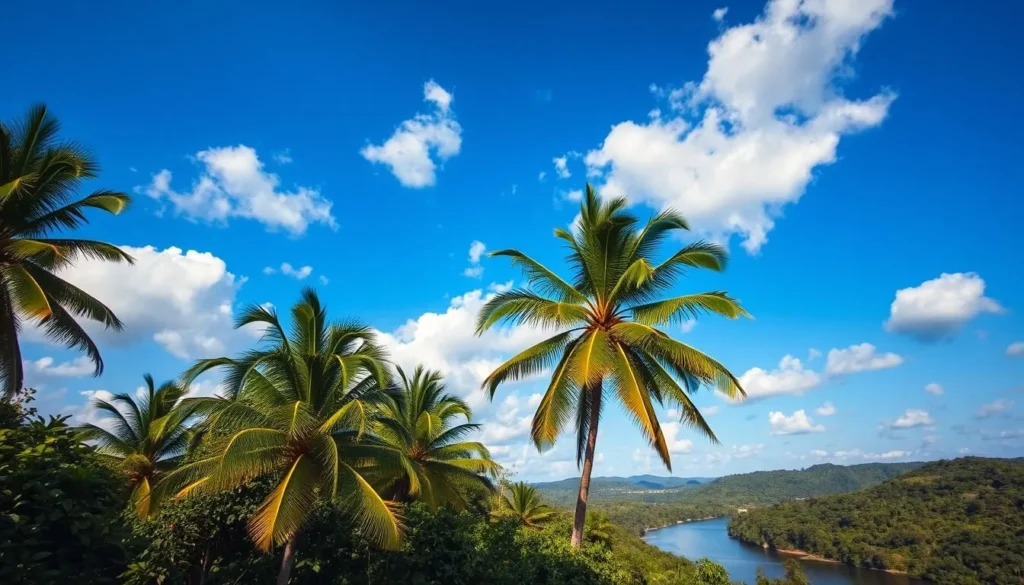
Beach conditions reach their annual peak during this period, making it ideal for swimming, fishing, and coastal tours. With calm waters along the Atlantic coast, you can enjoy a range of activities that make your trip to Suriname truly unforgettable.
Month-by-Month Weather Breakdown
To make the most of your visit to Suriname, it’s vital to understand the country’s weather patterns on a monthly basis. Suriname’s climate varies significantly throughout the year, with distinct wet and dry seasons that impact the conditions for various activities.
January to June Weather Patterns
The first half of the year in Suriname is characterized by a transition from the dry season to the wet season. January and February are excellent months to visit, with pleasant temperatures ranging from 20-30°C (68-86°F) and minimal rain.
- January offers warm temperatures averaging 79°F with relatively low rainfall of about 4.9 inches, making it ideal for exploring.
- February continues the pleasant trend with similar temperatures and even less precipitation (4.3 inches), excellent for beach activities.
- March remains largely dry with rainfall averaging 4.1 inches, creating good conditions for wildlife viewing.
- April marks the beginning of the transition toward the wet season, with rainfall increasing to 6.4 inches.
- May experiences a dramatic shift in weather patterns as the wet season begins, with rainfall nearly doubling to 9.8 inches.
- June represents the peak of the rainy season with approximately 25.5 wet days, though temperatures remain stable around 80°F.
| Month | Average Temperature (°F) | Average Rainfall (inches) |
|---|---|---|
| January | 79 | 4.9 |
| February | 79 | 4.3 |
| March | 81 | 4.1 |
| April | 81 | 6.4 |
| May | 81 | 9.8 |
| June | 80 | 12.5 |
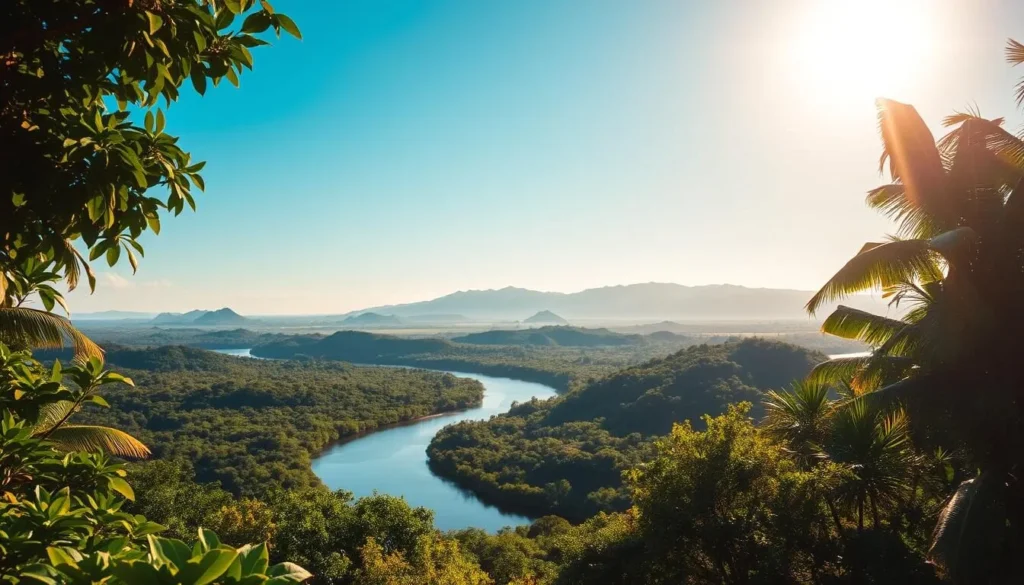
Understanding these weather conditions can help you plan your trip to Suriname effectively, ensuring that you make the most of your time in this beautiful country.
Planning Around Suriname’s Festivals and Events

To truly immerse yourself in Suriname’s culture, consider timing your visit to coincide with one of its many festivals. Suriname’s cultural calendar is rich with events that reflect its diverse heritage.
Suriname’s cultural calendar features festivals throughout the year, but the best time to visit for cultural immersion is during the dry season when outdoor celebrations can proceed without weather disruptions. Some notable events include:
- The Hindu festival of Holi-Phagwa in March, offering one of the world’s most colorful celebrations during a relatively dry period.
- Keti Koti (Emancipation Day) on July 1st, commemorating the abolition of slavery with vibrant parades and cultural activities.
- The Indigenous Peoples Day celebrations in August, coinciding with the peak of the dry season, offering perfect weather for traditional ceremonies.
- December’s holiday season, bringing numerous festivities that benefit from the beginning of the dry season.
Weather Considerations for Major Celebrations
When planning your visit around these cultural events, it’s essential to consider the seasonal weather patterns to make the most of your experience.
The dry season provides ideal conditions for outdoor celebrations, while the rainy season may impact some events. For instance, Holi-Phagwa in March is relatively dry, making it ideal, whereas Keti Koti in July falls during the rainy season.
Packing Tips for Different Suriname Seasons
Suriname’s diverse climate means that your packing list should vary significantly depending on the time of year you visit. The country’s tropical climate is characterized by distinct wet and dry seasons, each requiring specific essentials for a comfortable trip.
Understanding the seasonal variations will help you prepare for the activities you have planned, whether they’re beach-related or involve exploring the interior rainforest.
Dry Season Essentials
During the dry season, which spans from November to May, prioritize lightweight, breathable clothing that offers sun protection. Temperatures can reach the high 80s°F with intense sunshine, making high-SPF sunscreen a must for beach activities.
- Pack quick-drying clothes to accommodate brief afternoon showers.
- Bring at least one rain jacket to be prepared for unexpected rain.
- Include layers for temperature variations between coastal and interior regions.

By focusing on these essentials, you’ll be well-prepared for the dry season in Suriname and can enjoy your trip without worrying about the weather.
Health and Safety Weather Considerations
When traveling to Suriname, it’s crucial to consider the health and safety implications of the country’s tropical climate. Suriname’s consistently high temperatures and humidity levels present year-round health considerations that travelers should prepare for regardless of when they visit.
During the dry season, the combination of heat and sun exposure creates a risk of dehydration and heat exhaustion, making regular water intake essential even when you don’t feel thirsty.
Managing Heat and Humidity
The weather in Suriname remains oppressively humid throughout the year, which can exacerbate heat-related issues and make physical activities more taxing than in drier climates. To manage this, it’s essential to stay hydrated and take regular breaks in cool, shaded areas.
- The rainy season brings increased mosquito activity and associated disease risks, requiring diligent use of repellent and appropriate clothing, especially during dawn and dusk hours.
- Travelers with respiratory conditions should be aware that the transition periods between seasons can bring increased mold and pollen counts, potentially triggering allergies or asthma symptoms.
Accommodation and Transportation Weather Factors

When planning your trip to Suriname, understanding how weather affects accommodation and transportation is crucial. The country’s tropical climate means that weather conditions can significantly impact your travel experience.
The best times to visit Suriname for general outdoor tourist activities are from late July to late September and from late December to mid-March, with a peak score in the first week of February. This period offers clear, rainless days with perceived temperatures between 65°F and 80°F, ideal for exploring the country’s natural beauty.
Seasonal Pricing and Availability
Accommodation pricing in Suriname follows predictable seasonal patterns. The shoulder seasons of May-June and November-December offer the best value for budget travelers, with lower rates and manageable weather conditions.
During the peak dry season (August-October), popular lodges in nature reserves often book months in advance. Transportation reliability also varies by season, with interior roads becoming impassable during heavy rains.
Conclusion: Making the Most of Suriname’s Weather
Suriname’s diverse climate means that the best time to visit depends on your preferences and activities. For most travelers, the November to February period offers the ideal balance of comfortable temperatures and dry conditions, making it the peak tourist season.
If you’re looking to avoid crowds, consider the shoulder seasons. Your specific interests should guide your timing. For instance, August through October offers the most pleasant weather for general exploration and beach activities.
For wildlife enthusiasts, planning your visit during the transition months (April or November) can provide the best of both seasons. Regardless of when you visit, plan your daily activities around the weather patterns of that season.
Suriname’s relatively undiscovered status in tourism means that even during the “peak” months, you’ll find fewer crowds than in neighboring countries, allowing you to enjoy the best things this diverse country has to offer year-round.
—
The above is subject to change.
Check back often to TRAVEL.COM for the latest travel tips and deals.
